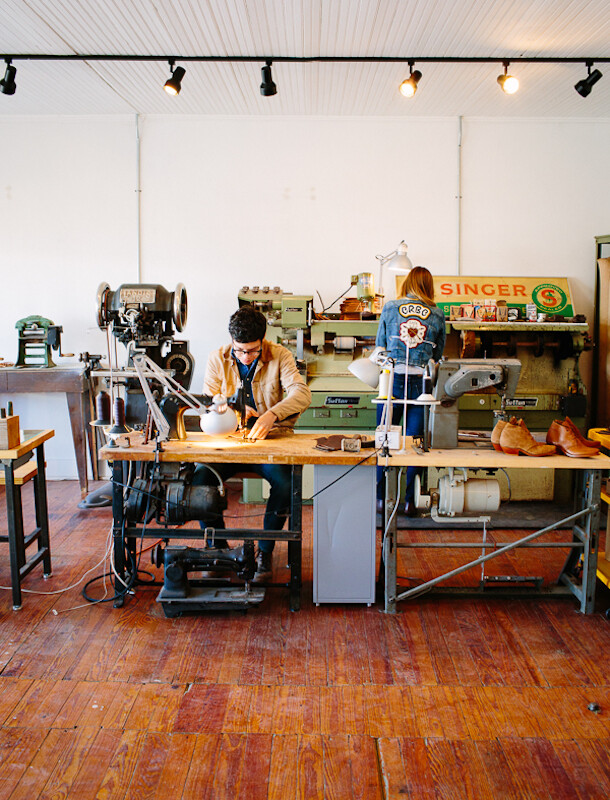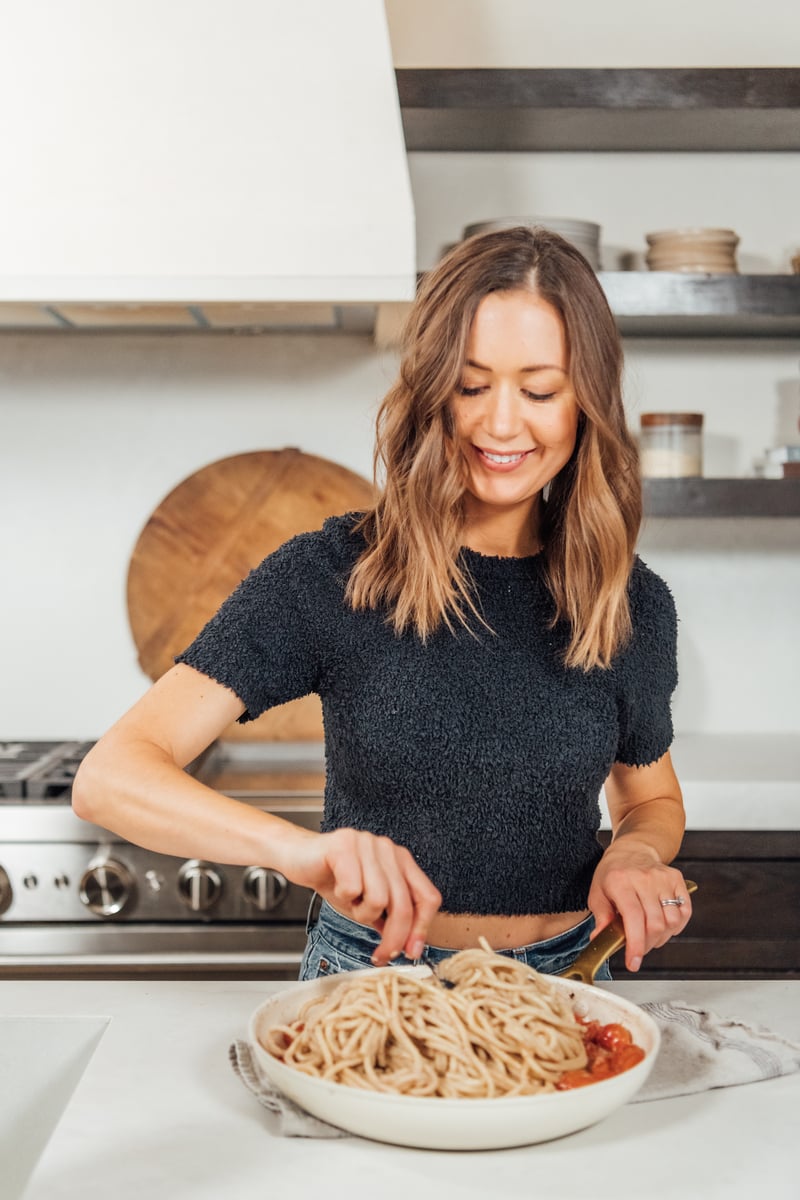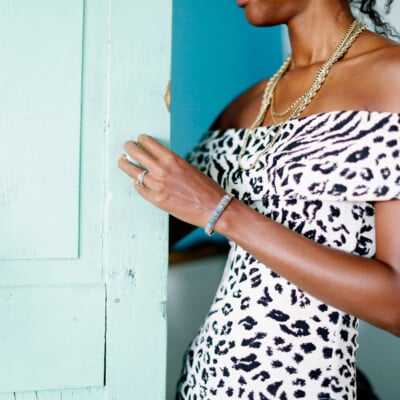A cowboy and a Canadian fall in love after meeting at a concert on a courthouse lawn in West Texas. Logan remembers the day — “I was spending the summer in Lubbock. I said hi to him, and he was so friendly when he responded that we got to talking and I remember thinking, ‘Wow, it’s true, Texans are so friendly!’ Later, he told me he had initially mistook me for someone he knew, which in retrospect was very lucky for us since we are both pretty shy and might not have met otherwise! We hung out that day, but I didn’t see him again for a couple weeks. One night I was at a red light and saw him riding a yellow bicycle across the street…I was so happy to see him that I yelled out his name from the opposite side of the intersection.” After that summer, Logan returned to Montreal where she was in school and Colt continued making custom cowboy boots from his garage in Lubbock. They would take turns making trips to visit. Colt, a native of West Texas and a fifth-generation cattle rancher, says: “If we didn’t have enough money to fly, we’d ride the Greyhound for over two days one way just to see each other.” How romantic is that? After daydreaming about starting their own boot line together, the couple settled in Marfa to join forces on the Cobra Rock Boot Company. Step inside their dreamy, creative life amongst the tumbleweeds of West Texas. (photography by Wynn Myers)

Everything is a creative collaboration when it comes to working on Cobra Rock, starting with designing the boots together and passing them back and forth through the process. “I feel like everything we make is drastically improved by the input of the other. Our designs have slowly transformed with us tweaking them after every pair. I’m really proud of the boots we are currently making, and I know that it would have never happened if Logan hadn’t joined me in the boot shop,” Colt says. “I may’ve never found the confidence to step away from building cowboy boots to starting our own line. I also like the actual production part because we get to hang out. When things are pretty slow around town, we like to turn on the radio or listen to a podcast together while we work.”

The adobe building that is home to the Cobra Rock headquarters used to be a dry goods store that was tacked on to the back of the original Borunda’s Cafe, where some of the first “Tex-Mex” food in the state was served. The L-shaped space is home to their sewing machines, cutting table, finisher and tools, and the retail space is in the back of the building. The location of their light-filled shop/studio (South Dean Street) is jokingly referred to as the “fashion district” of Marfa because there are two other workshops/stores on the block.

This outdoors-loving couple moved to Marfa when Logan got a job at the Chinati Foundation. “We had a beautiful apartment on the museum grounds that was a renovated barrack of Fort D.A. Russell and looked over one of the sheds that hold Donald Judd’s 100 works in mill aluminum,” Logan says. “In September of 2011, I was able to leave my job at the museum and we officially opened our Cobra Rock shop and store in our current space in November. For Colt, it was a change from doing custom work to doing our own line. For me I was learning from him and basically apprenticing while we made the boots… my hands had to turn from office hands to boot making hands pretty fast!”

It was on a hike in the Davis Mountains that the couple first dreamt up the idea of the South Highland Boot, a 1940’s squared-toed riding-heel boot combined with a contemporary lace-up desert boot. They are made in standard sizes with full-grain oil-tanned leather and an all-leather heel and sole. “The South Highlands are the culmination of what we love,” Logan says. “They’re rooted in cowboy history, but at the same time they’re their own thing. They’re something that is connected to the history here, but reflect our own time and experience.”


Logan spent her childhood in a small island community in British Columbia, Canada. She studied art history and photography in Montreal, Quebec, but a road trip through West Texas ignited a fascination with rural desert living that became the subject of her photography while living in Canada.

A selection of boot patterns in different sizes. They are made out of manila folders that they will then use to trace on the leather.

Various tacks resting on the top of the finisher.

Their work bench is often full of an assortment of tools, tacks and pegs.

Kathie Sever of Fort Lonesome in Austin, Texas made these custom chain-stitch patches for Valentine’s Day that Logan then found a perfect home for on the back of her denim jacket.

The duo is currently working on several new styles of boots, like the men’s version of the South Highland Boot and a new derby-style boot deemed the Chisos Boot, named after the rugged mountains of the Big Bend. All the South Highland boots are made with American full-grain oil-tannned leather.


Logan and Colt grew up in small towns and find solace in Marfa (population 2,000). “Living here is great. It seems like everyone in town is incredibly talented. My favorite nights are those when someone from the community who you may only know as a carpenter or electrician completely surprises you and has an art show, concert, film, or reading,” Colt says. “We are constantly impressed by the people here. It is also great to see just how supportive the town is, and it’s especially evident on those nights.”

Talk about a natural…these are the very first pair of boots Colt made when he apprenticed for a another bookmaker.

The couple first started thinking about launching their own line when they were living in a log cabin on Colt’s parents ranch. “It was really isolated and after we finished tying fence, we would ride dirt bikes about 45 minutes away to where he was keeping his boot equipment in an old airplane hanger. He was making custom cowboy boots and I got to see the full process of the boots being made from start to finish,” Logan says. “I practiced boot stitching patterns on leather scraps in the shop with him, and we daydreamed out loud about one day having a boot shop together, although we didn’t ever consider the idea seriously until we moved to Marfa.”

Colt’s father, an artist and rancher, has sculpted Southwestern bronzes like this cowboy who holds court in the shop for decades, and his work inspired the name Cobra Rock. “When I was about 4, I rolled out a couple of snakes, mashed their heads in to make them cobras, coiled them up like rattlers, arranged them on stack of rocks, and called it Cobra Rock. My dad must’ve liked it. He cast it in bronze and had it mounted on a little mesquite base,” Colt says. “When Logan first came to visit me at my parents’ house we found the sculpture. She thought it was hilarious, and she also thought Cobra Rock would make a great name for a boot company.”

There is a 3-6 month wait to score yourself a pair of Cobra Rock Boots. But, they do keep a few pairs in stock in their Marfa store.

Logan using the finisher to shape leather counters (heel stiffeners).

Click here to see more of Wynn’s photography.






